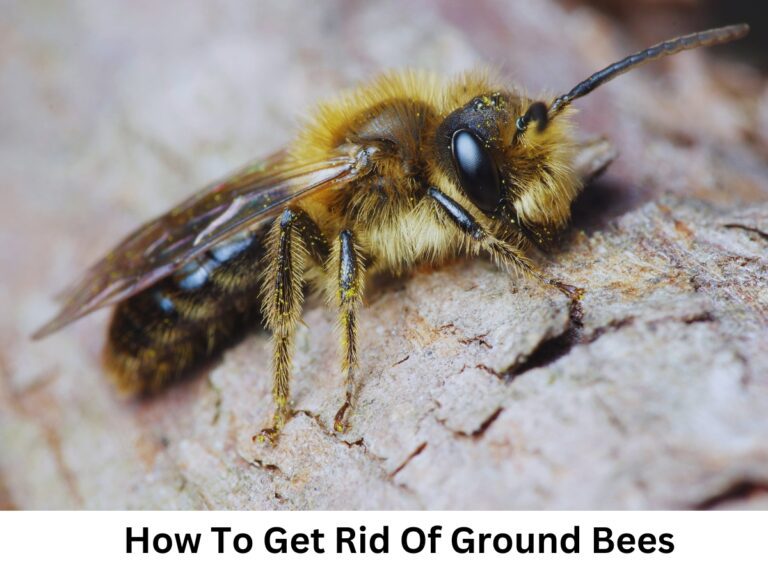This post might be created with help from AI tools and carefully reviewed by a human (Anthor Kumar Das). For more on how we use AI on this site, check out our Editorial Policy.
Can Bees Actually Eat Through Drywall? [Everyone Must Know]
No matter you are involved in beekeeping or not, do you have a beehive on the drywall of your house? Then it is a real worry for you.
You might be asking “Can bees eat through drywall?”
The truth is bees can easily eat through drywall if they need so. They can eat plenty of things like duct tape, woods, and other similar type of stuffs using their mandible. Drywall is not exceptional than that.
But don’t worry, all type of bees doesn’t try to eat through the drywall. This post will clear your all queries related to do bees really eat or chew through drywall.
Can Bees Eat Through Drywall?
Yes, Bees can eat through the drywall with their strong mandibles. But they will only eat through drywall unless this has become necessary for the welfare of their house.
If they decide to build their nest on the drywall, they will also eat through it if necessary.
Which Type Of Bees Will Eat Through Walls?
The most common type of bee that people find that can eat through drywall is the carpenter bee. Carpenter bees are solitary and usually build their nest inside a wood cavity. They can also build their nest if they find a small hole in a drywall.
Carpenter bees live individually and usually like to create their nest in a hole. They are most likely to create holes in the wood, tree, and also in the drywall of your house.
They have strong jaws compared to other types of bees. They can easily eat through drywall and create a hole inside the drywall using their strong jaw.
Another type of bee that can chew through drywall is the mason bee. This type of bees is not very aggressive. So, you can consider them risk-free. There are so many aggressive ground bees, but they are less likely to create their nest in drywall.
If your wall is made with strong elements, then bees won’t be able to create any holes and eat through it.

Other types of bees that rarely eat through drywall are bumble bees and honey bees.
Can Bees Chew Through DryWall?
Bees can chew through drywall if they are required to do so for their need. Suppose, bees are clustered together on a drywall. Due to some reason, they need to create an entrance hole through to the drywall. In such cases, bees will chew through the drywall to create their entrance.
Remember bees have a nectar-rich diet. They eat pollen and nectar. They may depend on other food sources when there are no flowers. But they won’t eat something like drywall to meet their hunger.
They will only chew through drywall or anything if it is creating an interruption to their colonial life. Normally ground carpenter bees like to create their nest in a cavity. This can be a small hole in the drywall.
The female carpenter will chew through the drywall to create more holes. Then she will lay eggs in those holes and raise her broods there.
Can Bees Go Through DryWalls?
Bees can chew and go through walls if required. But it is very rare to find such situations. Because carpenter bees and mason bees would like to create their nest on drywall. But their nest size is very small, less than 2 to 3 cm in diameter, and they usually don’t try to make a large hole to go through walls.
Bumble bees and honey bees might rarely try to create a beehive in the drywall. When a bee swarm can’t find a suitable nesting site, they might cluster together on a drywall temporarily. But they won’t try to create a hole from one side across the other side of the wall to go through.
What Happens If You Block The Entrance To A Bee Nest?
If you are a beekeeper then you might know that bees don’t like to have any disturbance to their normal life. We the beekeepers always work to save the bees and not to interrupt their colonial life.
So, if you block the entrance of your beehive then it could be very much disturbing for bees and they won’t like this. That could be the drywall of your house.
If there exists a disturbance like the drywall of your house to the entrance of the beehive. They will first try to chew through it to create a path for entrance.
There is also a high chance of losing your bees. They probably swarm away to find a safe place for their new home.
If you are not a beekeeper and try to block the entrance to a bee nest that can be harmful to you. Because bees might not like this, and they will try to sting you.
Also, if the thing that tries to create blocking of the bee nest is the drywall of your house then bees might eat the wall and come inside your house through the hole.
How Do You Tell If Bees Are Present In A Wall?
First of all, you have to be careful and look for some signs by which you can easily tell that you have bees on your wall.

The signs can be any one or more of the following:
- Spot Small Holes: Look for small circular holes in your wall. If you find one or more, then there is a chance that those holes are created by bees.
- Look For Buzzing Noise: After finding the small hole keep silent, and pay attention to detect any buzzing sound from the hole. If you are hearing any buzzing sound from your wall, then there is a high chance of having bees inside the wall. Don’t put your eye very close to the wall. If there is a bee present then it could hurt your eye.
- Look For Sticky Substances: If you find a hole but couldn’t find any buzzing sound. Then there is still a chance of creating the hole by any bee. She might go to collect pollen. In this situation, you have to look for sticky substances around the hole. If you find any that look like pollen then there is also a chance of having bees in the wall.
- Small Beeswax: If you find any tiny nest that looks like a small part of a beehive in the wall. That could be a small beeswax. So, this indicates that bees are about to create a new hive on your wall very soon.
If you investigate by following the above steps you will be able to tell if there is any bee in the wall or not.
What Do Bees Sound Like in a Wall?
Different types of bees produce different types of sounds. In general bees inside a wall produce sounds like vibration, buzzing, or humming sounds.
If you find any sound like this then there might be bees present inside the wall. Also, if you find any bees flying around the hole from which the sounds are coming that clearly indicates the hole is created by the bee.
How To Remove Bees From Drywall?
If you identify bees are present there don’t try to remove them on your own. Because if you try to create any interruption with them they won’t hesitate to sting you.
Moreover, even if you successfully destroy their house and remove them. There is a high chance they will look for a new house near to your home. And this could be even inside your home.
That’s why it is always preferable, don’t try to remove bees on your own unless you are a beekeeper.
You should call for an experienced pest control team to remove the bees. You can also contact your nearest beekeeper. You can also use a bee vacuum to relocate bees from your drywall to a suitable place.
Frequently Asked Questions
Is it okay to leave bees and a beehive alone in your wall?
If you just discover a group of bees clustering on your wall, you might leave them for some time. They might be looking for a nesting site around. So, there is a chance that they won't stay there long. If you see that after 2 days bees are still there, then call a bee professional to remove bees from the wall.
Do wasps eat through drywall?
Yes, wasps can eat through drywall if they had to. But they won't intentionally eat through drywall without any reason.
What can happen to the walls of your house if bees build a hive in there?
If they are living there for long, they might damage the wall slowly. But if your house wall is made with strong materials, there will be less damage. First, give them some time. If they don't leave the wall within a few days, call for a bee professional to remove them safely.
Final Thoughts And References
Bees can easily eat drywall and go through it if they require it. We shouldn’t create any disturbance to them.
If their hive is large and it seems to be dangerous for your home then call for an expert team to remove bees from your wall. Don’t go for it on your own.
Following are the resources that might be helpful for you.
- Research on “Solitary Bees that Inhabit Walls“. Read the article here.
- “A bee in the corridor: centering and wall-following”: This research aimed to investigate the mechanism of lateral collision avoidance in flying honeybees (Apis mellifera). Through experiments in a wide flight tunnel, the study discovered that honeybees exhibit distinct behaviors, either centering along the tunnel midline or following one wall. Read this.
- To learn 8 effective ways to get rid of ground bees read this.







